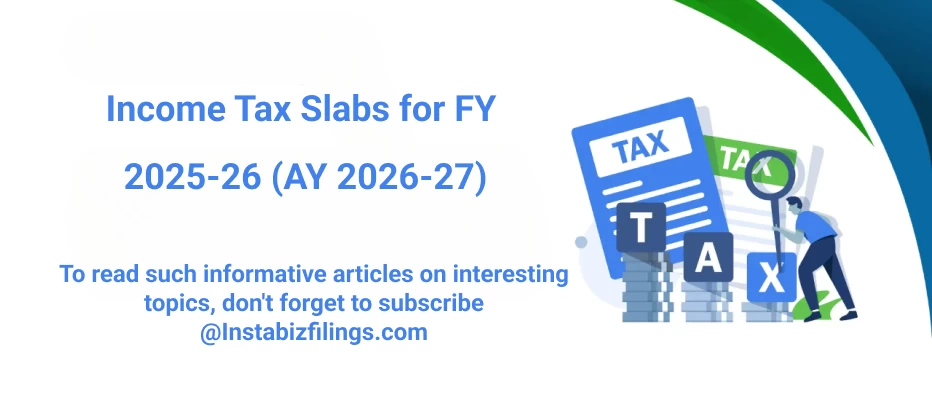
Income Tax Slabs for FY 2025-26 (AY 2026-27)
August 23, 2025 by Team Instabizfilings
Income tax slabs play a crucial role in determining the amount of tax to be paid by an individual or organisation in a given financial year. For the Financial Year 2025-26 (Assessment Year 2026-27), the system remains the same, with two options available: the New Tax Regime and the Old Tax Regime, as before. Depending on what is best to them, taxpayers may opt to use one of the two.
In this article, we are going to see the income tax slab rates in both regimes, exemptions and deductions applicable to them as well as advice on how to go about choosing the ideal.
What Are Income Tax Slabs?
Tax on income of India goes under a progressive tax slab. Thus, people earning a higher salary are the ones who pay more taxes. The slab system categorises income levels and applies tax rates accordingly.
Applicability of Income Tax Slabs
The tax slabs differ depending on a taxpayer type:
-
Single (less than 60 years)
-
These age groups (60-80 years) are termed as senior citizens.
-
Super Senior Citizen (80 years+)
-
HUF ( Hindu Undivided Family)
Income Tax Slabs for FY 2025-26 (AY 2026-27)
New Tax Regime(Base Regime from FY 2023-24)
Under the New Tax Regime, there are reduced tax rates; nevertheless, most exemptions and deductions are eliminated. This is what will happen after FY 2023-24 and taxpayers have the option to continue with the old regime in case they want.
|
Annual Income Range |
Tax Rate |
|
Up to ₹3,00,000 |
NIL |
|
₹3,00,001 – ₹6,00,000 |
5% |
|
₹6,00,001 – ₹9,00,000 |
10% |
|
₹9,00,001 – ₹12,00,000 |
15% |
|
₹12,00,001 – ₹15,00,000 |
20% |
|
Above ₹15,00,000 |
30% |
Rebate under Section 87A (New Regime): You can get a rebate under section 87A whereby you have zero tax rate provided your total income is less than or equal to 7,00,000 Rupees.
Key Features:
-
The Basic exemption of 50,000 is to be permitted IN FY 2023-24 onward.
-
There are no large deductions such as HRA, LTA, 80C, 80D etc.
-
Reduction of taxation rates on wider income brackets.
Old Tax Regime (Optional)
This is because under the Old Tax Regime, you are entitled to make different deductions and exemptions as follows:
-
INR.1.5 lakh under Section 80C
-
Health insurance of 80D
-
HRA, LTA and others
|
Annual Income Range |
Tax Rate |
|
Up to ₹2,50,000 |
NIL |
|
₹2,50,001 – ₹5,00,000 |
5% |
|
₹5,00,001 – ₹10,00,000 |
20% |
|
Above ₹10,00,000 |
30% |
Rebate under Section 87A (Old Regime): In case of your total income of 5,00,000 or below, you get a rebate amount of 12,500 and you will not have to pay tax.
Senior Citizen & Super Senior Citizen Tax Slabs (Pre Budget Only)
Senior Citizens (60–80 years)
|
Income Range |
Tax Rate |
|
Up to ₹3,00,000 |
NIL |
|
₹3,00,001 – ₹5,00,000 |
5% |
|
₹5,00,001 – ₹10,00,000 |
20% |
|
Above ₹10,00,000 |
30% |
Super Senior Citizens (80+ years)
|
Income Range |
Tax Rate |
|
Up to ₹5,00,000 |
NIL |
|
₹5,00,001 – ₹10,00,000 |
20% |
|
Above ₹10,00,000 |
30% |
Note: Super Senior Citizens and the Senior ones can only benefit with the old regime.
Which Tax Regime Should You Choose?
Choose New Regime if:
-
You do not claim many deductions.
-
Your investments and expenses do not fall under 80C/80D/HRA, etc.
-
You prefer a simplified return filing process.
Choose Old Regime if:
-
You invest in tax saving(CLS, ELSS,FPF).
-
You get deductions of 80C, 80D, HRA etc.
-
After you take away the deductions does significantly decrease your total taxable income.
Other Important Points for FY 2025-26
-
Income tax surcharge of 10 per cent on taxable income exceeding 50 lakhs to 5 crores.
-
Cess on income tax: Health, Education Cess: 4 % on income tax + surcharge.
-
Deadline to file Income Tax Return: 31st July 2026 (in case of majority of taxpayers).
-
To opt out (old regime) shall be as follows (new regime).
Conclusion
The Income Tax Slabs of the FY 2025-26 (AY 2026-27) follow the dual-regime with the flexibility to taxpayers. Compare your income, deductions, and exemptions to draw a conclusion on the old and new regimes. It is important to select the correct tax structure that would save a lot.
In case you are not sure which one of the two regimes will relate better with you, seek help from a tax expert or a tax calculator.
Disclaimer
The information provided in this blog is purely for general informational purposes only. While every effort has been made to ensure the accuracy, reliability and completeness of the content presented, we make no representations or warranties of any kind, express or implied, for the same.
We expressly disclaim any and all liability for any loss, damage or injury arising from or in connection with the use of or reliance on this information. This includes, but is not limited to, any direct, indirect, incidental, consequential or punitive damage.
Further, we reserve the right to make changes to the content at any time without prior notice. For specific advice tailored to your situation, we request you to get in touch with us.


